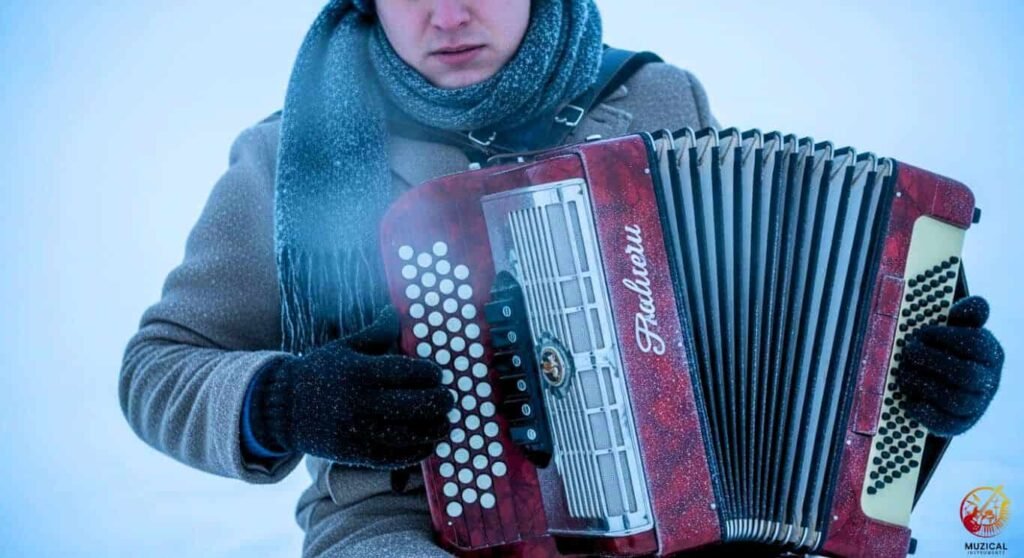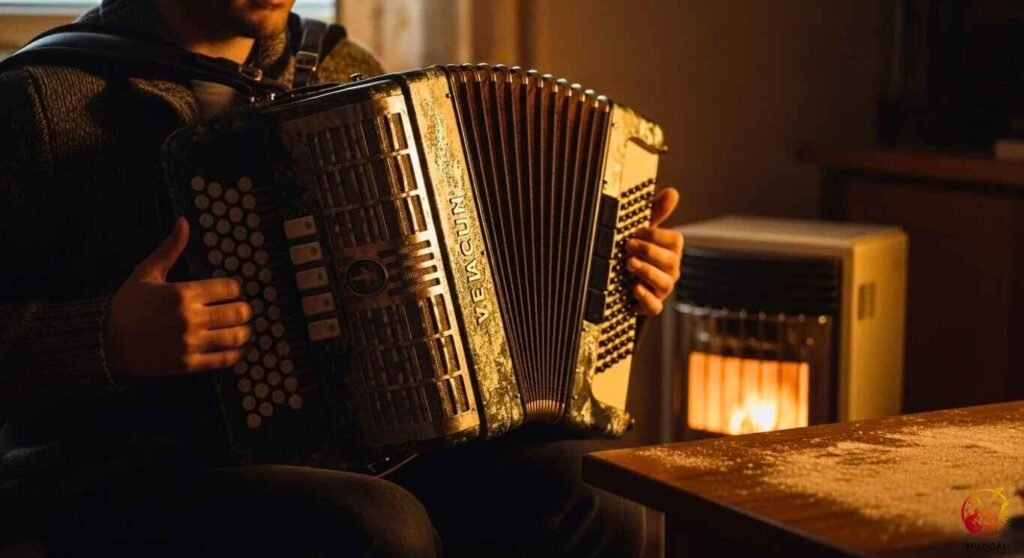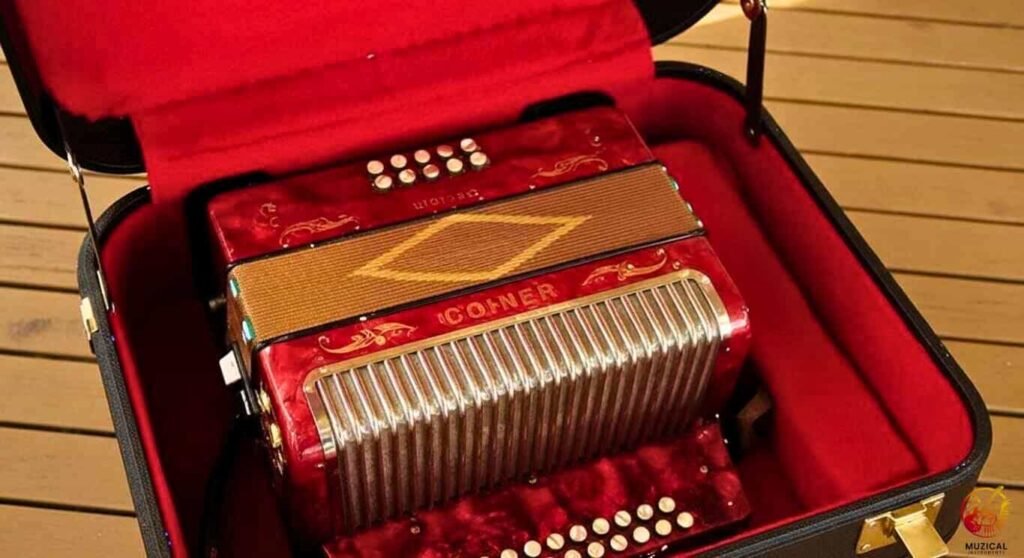Why Does Your Accordion Sound Flat in Cold Weather?
Cold temperatures make the metal reeds inside your accordion contract and get stiffer. This change messes with their vibration and throws the whole instrument out of tune. And this is why your accordion sound flat in cold weather. It’s a super common issue, but it can cause real problems if you don’t know what’s happening.
In this article you will learn:
- The physical reasons the accordion can go flat in cold weather
- What parts of the accordion are most vulnerable
- Practical steps to reduce flatness or restore tuning
- Care tips for cold conditions
- Answers to common questions people ask about this issue
Why does the accordion sound flat in cold?

To understand why your accordion sound flat in cold weather, you need to see how temperature, air density, and instrument materials all interact. Below are the main reasons, explained simply.
Temperature and speed of sound in air
Sound travels through air. Its speed depends on how warm or cold the air is.
- In cold air, molecules move slower, so sound waves go more slowly.
- In warm air, molecules move faster, so sound waves travel faster.
Because the speed of sound is lower in cold air, the same vibrating reed produces a slightly lower pitch (i.e. flat) compared to warmer conditions. This effect is well known in wind and reed instruments: they tend to go flat in colder air and sharp in warmer air.
Even small temperature changes (say, from 20 °C to 5 °C) can shift pitch by a few “cents” (a cent is 1/100th of a semitone) depending on instrument design.
So part of the “flatness” comes simply from the air around (and inside) your accordion being colder.
Material contraction and mechanical stresses
Besides the air, the accordion’s physical parts change when cold.
- Metals contract slightly when cooled. Parts like reed plates, screws, and plates may shrink.
- The wax that holds reed blocks or plates can become more brittle or cracked.
- The leather or adhesives in valves (pallets, gaskets) can stiffen or change shape in cold.
- If the reed plate shifts or is less tightly held (due to wax cracks or loosened adhesive), the effective vibration can change, making some reeds flatter or weaker.
If the reed isn’t held rigidly, part of its vibration energy is lost, or it vibrates slightly differently shifting pitch downward or causing “flat” notes.
Also, differences in contraction rates between different metals (steel reeds vs aluminum plates vs screws) might cause misalignments or rubbing contacts.
Moisture, condensation, and temperature shifts
Another hidden culprit is moisture.
- When you bring your accordion from cold outdoors into a warmer room, condensation can occur inside (on reeds, plates, leather).
- Water on or near reeds can damp vibration, slow motion, or temporarily lower pitch.
- Over time, humidity fluctuations may cause corrosion or rust, which subtly changes reed stiffness.
Thus, sudden temperature transitions worsen the problem.
Wax cracking / loose reed plates
Most accordions use wax or adhesive to fix reed plates to reed blocks. In cold weather:
- The wax may become brittle or crack.
- The reed plate may vibrate relative to the block instead of being rigidly fixed.
- That creates energy loss or shifts in how the reeds vibrate, often making them flatter or quieter.
A common indicator: if pressing gently on the reed plate causes a pitch change, that suggests wax or mounting issues.
Which parts are most vulnerable?
To know where to act, here are the accordion parts most affected by cold weather risk:
| Part | Vulnerabilities in cold | Consequences / symptoms |
|---|---|---|
| Reed tongues / plates | Metal contraction, shifted alignment | Pitch drift, some reeds flatter |
| Reed block & mounting wax | Wax cracking, adhesive weakening | Loss of resonance, pitch instability |
| Leather valves / gaskets | Stiffening, shrinkage | Leaks, weaker or “dead” notes |
| Mechanical parts (screws, fasteners) | Contraction, loosening | Misalignments, subtle mechanical noise |
| Bellows & frame | Contraction, possible small leaks | Reduced air pressure, less responsiveness |
| Reeds in humid / condensation zones | Moisture, corrosion | Sluggish reed flow, pitch damping |
Knowing this helps you target your care and repairs.
How to reduce flat sound in cold weather
Here is a step by step guide and practical tips to keep your accordion sounding better in cold conditions.
1. Warm up slowly, don’t rush
Before you play:
- Let your accordion adjust gradually to the indoor (or performance) temperature while it remains closed in its case. That helps avoid shock from temperature jump.
- Don’t immediately open and play when coming in from cold. Wait 10–20 minutes or more as needed.
- Avoid putting it directly next to a heater or radiator, which might heat unevenly and stress parts.

2. Air the reeds (without keys)
One practical trick used by accordion makers:
- Without pressing keys, pump the bellows and use the air button to move air through the reeds. This helps warm the internal parts gradually.
- This helps drive away condensation and brings internal components closer to ambient temperature.
3. Check and repair wax issues
If certain reeds remain flat:
- Test gently pressing the reed plate; if pitch changes, wax may be cracked.
- Rewax or re-mount the reed plates properly (this is delicate work; best done by a skilled technician).
- Avoid filing or making tuning adjustments until mounting integrity is secured.
4. Make small tuning compensations (if safe)
A well adjusted accordion may allow you to compensate:
- Use your electronic tuner in the performance environment to see how much flatness exists.
- If only a few cents, a professional may adjust reed tongues slightly (file or scratch) to counteract the normal cold shift but only if all underlying mechanical issues are resolved.
- Be careful: overcompensating may cause issues when temperature returns to normal.
5. Minimize temperature swings in storage

Preventative care is best:
- Don’t leave the accordion in a cold car overnight (wax or adhesives may be harmed).
- Use a well insulated case.
- Avoid carrying the accordion from extreme cold directly to a heated room and opening it immediately.
- Store in moderate temperature and humidity if possible.
6. Seasonal check
Before cold weather performances:
- Get your accordion serviced: inspect wax, check reed mounting, ensure valves and gaskets are in good shape.
- Test it in a cooler room to see how it responds.
- If possible, tune slightly “cool” (so it drifts into true tuning when cold). But this is a delicate judgment.
Real world example
Suppose you live in a place where daytime is 5 °C and indoor rooms are ~22 °C.
- You take the accordion outside to play, then bring it back in.
- The reeds and internal parts are still cold, while room air is much warmer and humid, condensation may occur.
- If you open and start playing immediately, the air inside your reeds is cold, so pitch is lower than expected.
- Also, if wax has micro cracks, some reeds shift slightly, compounding flatness.
- Over 10–20 minutes, internal parts warm, moisture evaporates, and pitch comes closer to normal.
With practice, you learn to wait before playing, and to warm internally first.
Common mistakes beginners make
- Opening the instrument immediately after bringing it inside
- Filing reeds before solving mounting or wax issues
- Leaving the accordion in extreme cold or heat for long times
- Ignoring microcracks in wax or adhesive
- Forgetting humidity and condensation effects
Avoid these and you’ll reduce many cold-weather tuning problems.
Why accordion tuning in winter is special
Because your accordion uses reeds, wax mounting, leather valves, and many small metal parts, it is more vulnerable to cold effects than many solid body instruments.
- Reeds are delicate and react strongly to small shifts.
- Wax mounting is temperature sensitive.
- Leather and adhesives change properties in cold.
- Humidity and condensation are more dangerous, since reeds and internal parts are exposed.
So even though the same physics (cold air, contraction) affects many instruments, your accordion has several weak points that must be managed proactively.
Summary and final thoughts
- Your accordion can sound flat in cold weather because colder air slows down sound waves, plus parts contract, wax may crack, and moisture can interfere.
- The most vulnerable parts: reed mounting (wax), reeds, valves/leather, mechanical fasteners.
- To reduce the problem: warm gradually, ventilate internally, inspect and repair mounting, avoid extreme temperature shifts, and tune under realistic conditions.
- A seasonal check with a technician is very helpful before winter performances.
If you manage these factors, your accordion sound flat in cold weather problem will shrink. Your music will stay reliable no matter the chill.
FAQ: Accordion Sound Flat in Cold Weather
1. Why does my accordion sound sharp to my electronic tuner but flat with my band?
Your tuner is showing you the physical reality: the cold made your reeds vibrate faster, raising their pitch (making them sharp). However, your band is likely playing at the standard A=440Hz pitch. When your sharp accordion clashes with their in-tune instruments, the resulting sound can be perceived as “off” or “flat” because it doesn’t fit harmonically.
2. How long do I really need to let my accordion acclimate?
A minimum of one hour is a good rule of thumb. If the accordion was left in a freezing car for several hours, or if the temperature difference between outside and inside is extreme (e.g., more than 20°C / 40°F), waiting two to three hours is much safer.
3. Can I use a hairdryer to speed up the warming process?
Absolutely not. This is one of the worst things you can do. The intense, direct heat can melt the sensitive beeswax that holds the reeds, crack the celluloid finish on the body, and warp the internal wooden parts. Slow and steady is the only safe way.
4. Can cold weather permanently damage an accordion?
Yes. While a simple tuning change is temporary, the condensation caused by rapid temperature changes can cause permanent damage like rusted reeds, warped reed blocks, and weakened wax. This damage is expensive to repair.
5. What is the ideal temperature and humidity for storing an accordion?
Most experts agree that accordions are happiest in the same environment humans are: around 20-22°C (68-72°F) with a relative humidity of 40-60%. Avoid storing them in attics, basements, or garages where temperature and humidity fluctuate wildly.
6. Do I need to get my accordion retuned every winter?
No. If you care for it properly, the tuning should return to normal once the instrument is fully acclimated to a stable room temperature. You only need a professional retuning if notes are still out of tune after the instrument has been in a stable environment for a full day, or if you have damage from rust or loose reeds.
